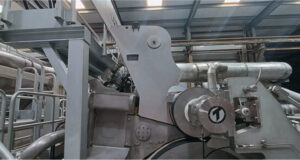At Metsä Tissue in Katrinefors, Sweden, de-inked pulp from recycled waste paper is used in the production of tissue paper. During the process, broke generated during web breaks in the paper machine or from finished paper that is discarded is normally sent to a pulper for dissolving and then mixed in with other pulp to be reused in the tissue machine.

Mårten Karlberg, Cellwood, with Peter Colliander and Mikael Käll, Metsä Tissue.
“There can be problems with reusing broke when it comes from wet-strength material,” says Mikael Käll, who works as a development engineer at the Katrinefors mill. “Such material is difficult to dissolve properly in the pulper, which means flakes remain in the pulp. When that pulp reaches the paper machine there is an increased risk of web breaks.”
The paper mill in Katrinefors has two paper machines, six conversion lines, and a deinking plant for handling recycled paper. The mill produces hygiene paper and paper rolls for the industry. The production is 75,000 metric tpy.
In early 2017, Metsä Tissue Katrinefors upgraded with a Krima disperser in a new type of application. The disperser treats broke from the tissue machine in order to strengthen fiber. This gives a stronger paper quality, which increases uptime.
During dispersion, flakes in the pulp are disintegrated in an effective way, which enables recycling of wet-strength broke without the risk of web breaks. The same disperser is also used to loosen fiber bundles in stored surplus pulp from the DIP line. In both cases the dispersion leads to increased fiber strength properties and a stronger paper.
FLEXIBLE CONCEPT
The new installation prevents the problem with flakes. After the broke pulper, a disperser has been installed for additional disintegration of the pulp. The fibers are treated for increased strength properties at the same time as flakes and fiber bundles disappear.
“Dispersion is the only technology that leads to strengthened fiber properties,” Käll explains. ”Stronger paper in the paper machine means a decreased risk of stand-stills. More uptime means a higher capacity. And of course we also get a better end product.”
The new installation is part of a flexible concept that also takes care of other problems. The same disperser is used for treatment of stored surplus pulp.
“We have a process where we keep producing pulp, even when the tissue machine stands still,” says Peter Colliander, production engineer. “The surplus pulp is diverted from the main line, then it is dewatered in a screw press and stored as a buffer.”
The pulp is kept in storage for up to eight days, and is redirected into the main line when there is a shortage of other pulp. However, after processing through the screw press, fiber bundles appear in the pulp. Also, the strength properties of the fibers decrease after a few days in storage. When this pulp is reintroduced into production, there is a risk of weakened paper and web breaks in the machine.
“This is a problem that we have looked into on earlier occasions,” Käll says. “At that time we were considering a deflaker to loosen up the stored pulp. But as our required capacity is 200 metric tpd, such a setup would have required three separate deflakers in parallel. Therefore, a disperser was a better choice—it meant we could handle the full capacity in one single machine. With a disperser we can also profit from all advantages with strengthened fiber.”
“The new disperser is very valuable for production,” Colliander says. “With increased fiber strength we can feed the paper machine with 100 percent storage pulp, without risk of web break.”
Käll finds the flexible concept very useful. “The combined functionality takes care of both the previous problems with wet-strength broke and storage pulp,” he says.

When the stored pulp is reintroduced into the production it is first processed through the disperser, where the fibers are treated for increased strength properties.
HOT DISPERSING SYSTEM
The new disperser is not the first Cellwood machine at Metsä Tissue Katrinefors. Since 1996 a central part of the production has been based on a Krima Hot Dispersing System. That is a complete system with dewatering, steam heating and dispersion, which transforms incoming waste paper to pulp, free from contaminants and with strengthened fiber.
Dispersion is an environmentally-friendly and economical technology for treatment of recycled paper. The mechanical process disintegrates contaminants in the pulp to invisible size, decreasing the need of bleaching chemicals. The high temperature (up to 120°C/248°F) melts inks and tacky contaminants while killing bacteria.
For the disperser, mills can choose from a variety of different dispersion discs to achieve the optimal treatment effect on each specific paper type. The disc gap can be changed online with an accuracy of 0.01 millimeter. The optimal configurations are investigated in the beginning of the project through a trial run at Cellwood’s Research & Technology Center (RTC). The RTC offers a complete set of machinery plus a laboratory for analysis of the results from different machine settings.
DEVELOPMENT PROJECTS
The project with the new disperser installation is also not the first time the Katrinefors mill piloted a new concept from Cellwood. In the mid-1990s the mill installed the first prototype of Cellwood’s screw press model KSR, which now has become a proven standard in applications all around the world.
“We can see that numerous upgrades have been made on the new disperser, compared to the one we’ve operated since the ’90s,” Colliander says. ”The control panel is easier to maneuver and service is more accessible. It is a user-friendly feature that the disperser is installed on a track and automatically can be moved backwards when it needs to be opened for dispersion disc replacement.”
“The new disperser facilitates production here in the mill. It is a successful installation that increases our uptime and capacity,” Käll concludes.

The new Krima disperser is used for treatment of wet-strength broke and storage pulp.
 Paper 360
Paper 360
